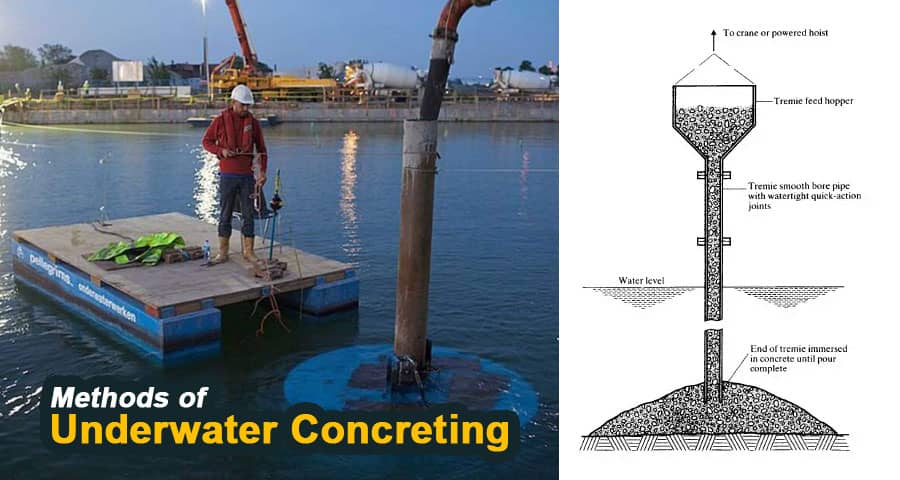Methods of Underwater Concreting: Techniques and Best Practices

Introduction
Underwater concreting is a specialized construction method that involves placing and curing concrete underwater, enabling the creation of structures such as bridges, dams, and offshore platforms. This article delves into the diverse techniques employed in underwater concreting, highlighting their unique advantages and addressing the key considerations for successful implementation. From traditional methods to cutting-edge technologies, we explore how engineers and construction professionals navigate the complexities of working beneath the water's surface.
Methods of Underwater Concreting
Concrete, a versatile and durable construction material, becomes a challenge when placed underwater due to factors like water pressure, buoyancy, and curing conditions. Various methods have been developed to overcome these challenges, ensuring the integrity and longevity of underwater structures.
- Tremie Method: The Tremie Method is a widely used technique that involves pouring concrete through a large funnel-like hopper, known as a tremie, to ensure a continuous flow without segregation. As the concrete exits the tremie pipe, it displaces the water and settles at the desired location on the submerged surface. This method minimizes the risk of voids and ensures uniform distribution of concrete particles.
- Pumping Underwater: Pumping is another efficient method for underwater concreting. Concrete is mixed on a platform or vessel and pumped through pipelines to the placement area. By controlling the water-cement ratio and utilizing specialized admixtures, engineers can achieve the required consistency and strength of the concrete mix. Pumping offers flexibility in reaching challenging underwater locations.
- Preplaced Aggregate Method: In the Preplaced Aggregate Method, specially designed bags or containers filled with aggregate and cementitious materials are carefully placed underwater. Once in position, these containers are punctured, allowing water to flood in and initiate the curing process. This method is advantageous for repairs and rehabilitation projects.
- Hydrodynamic Placement: Hydrodynamic placement leverages the natural flow of water to transport and deposit concrete mixtures. By carefully timing the placement with the ebb and flow of tides, currents, or controlled water releases, engineers can achieve precise positioning of the concrete without the need for external force.
- Underwater Concrete Bags: Underwater concrete bags provide a convenient solution for small-scale underwater concreting tasks. These bags, filled with pre-mixed concrete, can be manually placed and arranged to form the desired structure. They are particularly useful for quick repairs, such as fixing underwater pipelines or culverts.
- Polymer-Modified Concrete: Incorporating polymers into concrete mixtures enhances their workability, adhesion, and durability underwater. Polymer-modified concrete is designed to resist water infiltration and maintain its strength in submerged environments. This method is gaining popularity for its ability to withstand challenging underwater conditions.
- Pneumatically Applied Mortar: Pneumatically applied mortar involves using compressed air to propel a mixture of cement, sand, and water onto the underwater surface. The impact fuses the mortar with the substrate, creating a bond that can withstand water pressure. This method is commonly used for repairing marine structures.
Overcoming Challenges and Ensuring Success
The methods of underwater concreting offer promising solutions, but they come with their own set of challenges. Maintaining the quality and consistency of the concrete mix, preventing segregation, and ensuring proper curing are paramount for the success of any underwater construction project. Additionally, safety measures for divers and construction personnel play a critical role in achieving successful outcomes.
FAQs
How do engineers prevent the concrete mix from washing away during underwater placement?
Engineers use specialized additives and admixtures to control the density and viscosity of the concrete mix, preventing it from dispersing in the water.
What are the key factors considered when selecting an underwater concreting method?
Factors such as water depth, project size, accessibility, and desired structural performance influence the choice of underwater concreting method.
Can polymer-modified concrete be used in deep-sea applications?
Yes, polymer-modified concrete is suitable for deep-sea applications as it offers enhanced durability and resistance to corrosive saltwater.
Are there environmental considerations for underwater concreting?
Absolutely, environmental impact assessments are conducted to ensure that underwater concreting activities do not harm aquatic ecosystems.
How do construction professionals ensure the safety of divers during underwater concreting?
Safety protocols, proper training, and equipment checks are essential to protect divers from hazards associated with underwater construction.
Can underwater concreting methods be used for repairing existing underwater structures?
Yes, methods like pneumatically applied mortar and underwater concrete bags are particularly effective for repairing and rehabilitating underwater structures.
Conclusion
As construction projects continue to expand into aquatic environments, the methods of underwater concreting become increasingly important. Engineers and construction professionals leverage a variety of techniques to overcome challenges and ensure the successful realization of underwater structures. From the tried-and-true Tremie Method to innovative approaches like polymer-modified concrete, each method contributes to building a sustainable and resilient underwater infrastructure. By understanding the intricacies of these methods and prioritizing safety and environmental considerations, we pave the way for a future where underwater construction is both efficient and environmentally responsible.
